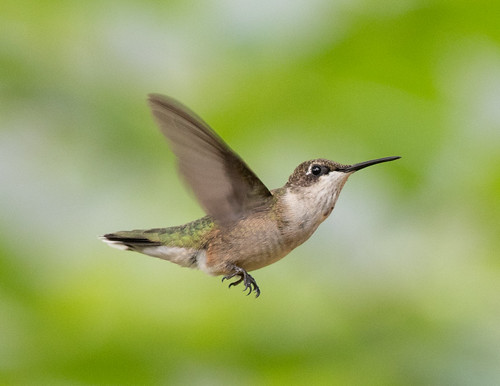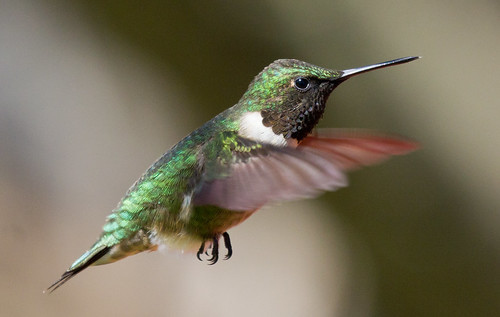The seasonality of life can be entirely different within just one single species, sometimes varying by age, sex, or both.
Take Ruby-throated Hummingbirds. From the end of June through the first half of July, a lot of people up here were emailing me or complaining on Facebook about how few hummingbirds were coming to their feeders. That’s the time of our summer season when adult female hummingbirds are focused on raising young and searching for high-protein insects to feed them. They raise one or two broods each summer, each clutch of two eggs in a brand-new nest that the female built.
After laying the eggs, she spends about two weeks incubating them, then three weeks feeding the nestlings by regurgitation, and then stays with the fledglings for another week or so. And most adult males, not focused on baby care but still interested in mating with females who may be starting second broods, spend their time closer to where the females are than at our feeders. On my corner of Peabody Street this year, one female must have been nesting in a tall tree in mine or my neighbor’s backyard—I saw her almost daily, sometimes several times each day, but always high in the trees, never near my feeders. The few times I got a glimpse at a male, he was up there, too.
As early first broods of hummingbirds fledge, many mothers lead their offspring to natural food both for the chick’s sake and their own. They visit the colorful flowers we associate with hummingbirds, but even more often to the drabber flowers high up in shade trees and other inconspicuous feeding spots.
Hummingbirds burn a lot of carbs in their day-to-day lives, and incubating eggs is even more energy-intensive, but producing those eggs requires protein, and the growing nestlings and fledglings, building body mass, muscle, and feathers, need even more protein. Locally native herbaceous flowers, shrubs, and trees provide both high-carb nectar and high-protein insects. When females start a second clutch, their newly independent first brood continues feeding mostly where their mother taught them for days or even weeks before they discover feeders. But some mothers do introduce their young to feeders. When two or three hummingbirds feed peacefully at a feeder without any chasing, that’s usually a mother showing her young a new food source.
Once adult females start incubating a second clutch of eggs or it’s too late in the summer to start a second brood, they lose interest in sex, which is when adult males lose interest in them. When no more interested females remain near a male’s territory, even as the child-rearing season continues for the females, adult males transition from their mating season to their bulking up, pre-migration season.
Those males enter their migration season weeks before adult females or young hummers. By late August it’s rare to see a hummingbird with a red throat.
The depleted mothers take much longer than their mates to reach migratory condition. As fledglings reach full independence, they also focus on bulking up—the last chicks to fledge, here and further north, are usually the ones visiting our feeders into September. They know they must migrate. It’s not our feeders holding them north—they simply cannot head out until their bodies are in the best condition and at the right weight.
This year’s drought, impacting both herbaceous plants and trees, may have affected nesting success, and it’s almost certain that poor air quality from so many fires has taken an even larger toll on birds than on humans—birds can’t retreat indoors with air filters when their lungs start hurting. That’s the sort of health situation that doesn’t outright kill birds or humans, but compromises health and can mean life or death in a physically demanding situation.
Fall migration isn’t a single straightforward season for Ruby-throated Hummingbirds—first comes the moseying part when they head to the Gulf Coast, mostly by day, resting and feeding along the way as opportunities arise.
The Gulf of Mexico represents a fork in the road, and they have two options. Some strike out directly over water to the Yucatán Peninsula, a minimum of 500 miles away if they started out at exactly the Mississippi Delta and if they arrive exactly at the tip of the Yucatán. The journey is usually significantly farther than that depending on where they take off and land and how much the wind throws them off course. No matter how long the journey, these birds take off after a big breakfast and fly every moment of the rest of that day, throughout that night, and well into the next day before they reach landfall to finally rest and eat again. Ruby-throats in the best physical condition to start with seem to be the ones who take this direct over-water route.
The ones moving along the coastal land route have a much longer journey, and not less treacherous—either way, all these tiny birds are making this difficult passage during the peak of hurricane season. Just thinking about that makes me terrified for them, but even the tiniest birds are far less likely to be consumed by fear than we lesser beings are.
Our Ruby-throats don’t breed during their time in the tropics, but it’s hardly a vacation. They must compete for food with the dozens of hummingbird species already there, most of which are larger and already familiar with the landscape. And there are a host of tropical dangers such as bird-eating spiders, a host of small raptors, and large flycatchers. And some snakes lurk within the foliage of tropical plants to strike out at any bird that might approach the flowers. The first time I was in Costa Rica, I set up a microphone and recorder at a feeding station. When I returned, a few hummingbirds were chattering aggressively at the cord while moving in hovering flight along its length—they must have thought it was a snake, and I felt very guilty that my equipment had disturbed their day. (You can hear the 10-minute recording of hummingbirds flying by, some cursing the microphone cord, here. I don't have a photo.)
Despite all the dangers to and fro and in between, every year sometime around Mother’s Day, hummingbirds reappear in my yard. Every single one of these birds that weighs only an eighth or a tenth of an ounce (you could mail at least 8 of them with a single postage stamp!) survived its long migration down to Mexico or Central America, the treacherous season in the tropics, and its long migration back here. Imagine that! And if that’s hard to believe, I can barely wrap my head around an even more incredible fact: there are four records of hummingbirds listed on the Patuxent Bird Banding Lab website who were caught, all alive and healthy, more than 8 years after first being banded. (All four of them were quickly released after recapture.) All four had been originally banded as an adult, so they were each a minimum of 9 years old when retrapped and released. Some or all may quite possibly have been even older than that!
Some people look up to the heavens in search of miracles. Me, I just direct my eyes to my hummingbird feeders.







